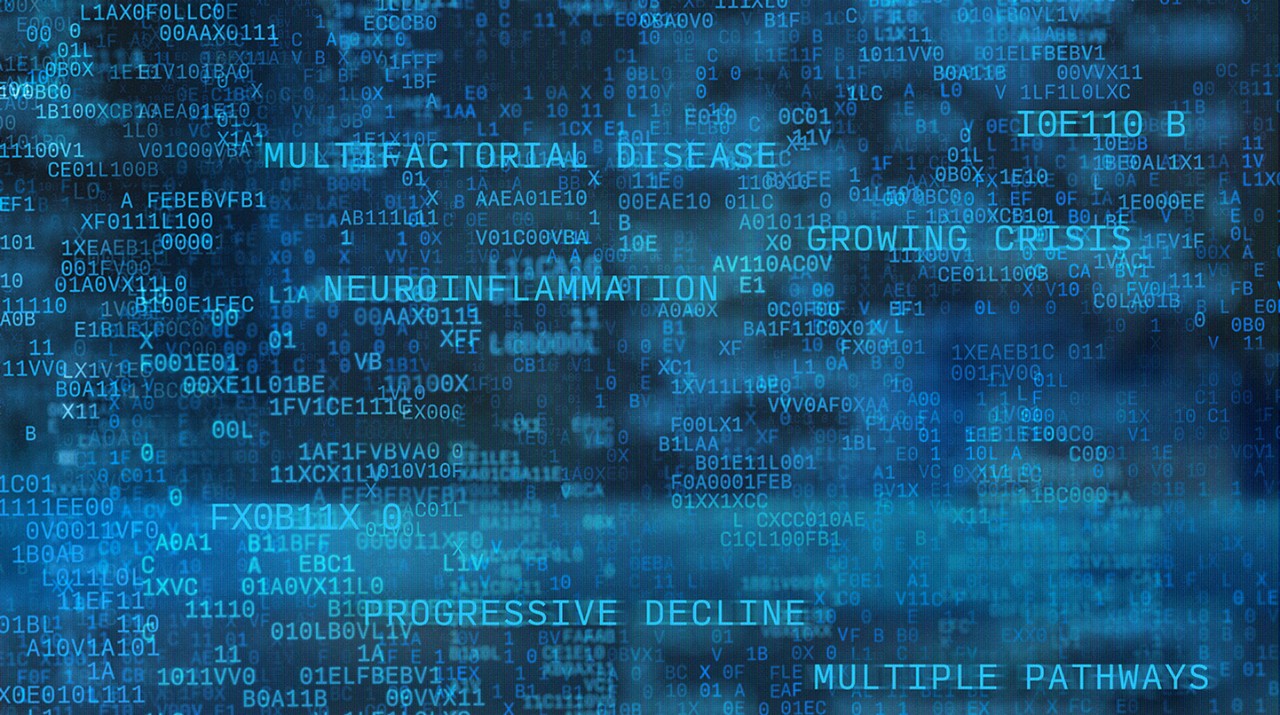
Actor portrayals.
A GROWING CRISIS
The number of Americans living with AD is expected to DOUBLE BY 2060, increasing from 6.9 million in 2024 to 13.8 million.1,3*
*Americans aged ≥65 years.
Health care systems and health care professionals must be prepared to handle the growing number of patients with AD—taking immediate action to diagnose and help slow the progression of this devastating disease.3
EVOLVING PERSPECTIVES
Emerging science could change how we approach the AD crisis.
The devastating impact
Alzheimer’s disease is devastating for both patients and care partners4
AD is a type of dementia that affects memory, thinking, and behavior.1,5,6
Symptoms can include1,5,6
Progressive memory loss
Decline in OTHER cognitive domains
including impairment in reasoning skills and visuospatial orientation
Neuropsychiatric symptoms
such as changes in mood (depression) and agitation
Stages of Alzheimer’s disease
Pathological changes in the brain can begin decades before symptom onset in AD, and once symptoms occur, cognitive function only worsens with time.1,7
Preclinical AD*
STAGES 1 + 2†
10-20 years prior to symptoms
Asymptomatic but with possible biological changes in the brain, as evidenced by positive biomarker tests including amyloid and/or tau PET and CSF tests1
- No symptoms or self-reported mild changes in mood or cognition (stage 2) with no objective cognitive decline1
Mild Cognitive Impairment (MCI) Due to AD*
EARLY AD
STAGE 3†
Mild cognitive symptoms that may not interfere with everyday activities as evidenced by positive biomarker tests including amyloid and/or tau PET and CSF tests8,9
Symptoms can include‡:
- Difficulty with word recall and word finding
- Difficulties with orientation to time and place
- Memory loss that disrupts daily life (eg, forgetting important appointments)1
NOT NORMAL AGING
It’s important to distinguish between MCI and normal aging.
Mild Dementia Due to AD*
EARLY AD
DEMENTIA DUE TO AD
STAGE 4†
Progressive cognitive and mild functional impairment of instrumental activities of daily living (ADLs)8,9
Symptoms can include‡:
- Decline in executive functions: difficulties with attention and concentration, impaired judgment and problem-solving abilities
- Difficulty remembering complex sequences and completing familiar tasks1
Moderate Dementia Due to AD*
DEMENTIA DUE TO AD
STAGE 5†
Progressive cognitive and moderate functional impairment with basic ADLs requiring assistance8,9
Symptoms can include‡:
- Decline in visuospatial skills, visual perception, and fine motor skills
- Decline in verbal fluency and word comprehension
- Changes in mood such as depression, social withdrawal, and agitation1
Severe Dementia Due to AD*
DEMENTIA DUE TO AD
STAGE 6†
Progressive cognitive and functional impairment with complete dependence on basic ADLs8,9
Symptoms can include‡:
- Widespread decline in language functions (patient may be limited to few words or phrases or become aphasic)
- Possible loss of mobility
- Vulnerability to infection
- Loss of awareness of experiences and surroundings
- Complete loss of independence
- Patient requires around-the-clock care1
| * | Syndromic stages based on clinical evaluation. |
| † | Numerical clinical stages (biologically confirmed AD). |
| ‡ | Examples of symptoms reflect decline in distinct cognitive and functional domains as the disease progresses through different stages. |
| CSF, cerebrospinal fluid; PET, positron emission tomography. | |
AD also has a profound impact on care partners1,10

report
high EMOTIONAL stress*

report
high physical stress*
*Results are from a 2014 telephone survey of 3,102 Americans aged 18 years or older who provided unpaid care to a relative or friend aged 50 years or older with Alzheimer’s or another dementia in the past 12 months.
Ongoing research is shifting our understanding on what drives AD development and progression.5,7,11,12
Detection in primary care is essential to early AD diagnosis.3,13,14
- Alzheimer’s Association. 2025 Alzheimer’s Disease Facts and Figures. Accessed May 22, 2025. https://www.alz.org/getmedia/ef8f48f9-ad36-48ea-87f9-b74034635c1e/alzheimers-facts-and-figures.pdf
- Fisher Center for Alzheimer’s Research Foundation. Alzheimer’s disease facts and statistics. Accessed May 7, 2025. https://www.alzinfo.org/understand-alzheimers/alzheimers-disease-facts-and-statistics/
- Alzheimer’s Association. 2024 Alzheimer’s Disease Facts and Figures. Accessed May 22, 2025. https://www.alz.org/getmedia/c65b6229-48cf-4a7b-a447-328fdf05e35d/alzheimers-facts-and-figures-2024.pdf
- Vu M, Mangal R, Stead T, Lopez-Ortiz C, Ganti L. Impact of Alzheimer’s disease on caregivers in the United States. Health Psychol Res. 2022;10(3):37454.
- Zhang J, Zhang Y, Wang J, Xia Y, Zhang J, Chen L. Recent advances in Alzheimer’s disease: mechanisms, clinical trials and new drug development strategies. Signal Transduct Target Ther. 2024;9(1):211.
- National Institute on Aging. What are the signs of Alzheimer’s disease? Accessed May 7, 2025. https://www.nia.nih.gov/health/alzheimers-symptoms-and-diagnosis/what-are-signs-alzheimers-disease
- Hampel H, Hardy J, Blennow K, et al. The amyloid-β pathway in Alzheimer’s disease. Mol Psychiatry. 2021;26(10):5481-5503.
- Jack CR Jr, Andrews JS, Beach TG, et al. Revised criteria for diagnosis and staging of Alzheimer’s disease: Alzheimer’s Association Workgroup. Alzheimers Dement. 2024;20(8):5143-5169.
- El-Hayek YH, Wiley RE, Khoury CP, et al. Tip of the iceberg: assessing the global socioeconomic costs of Alzheimer’s disease and related dementias and strategic implications for stakeholders. J Alzheimers Dis. 2019;70(2):323-341.
- Grabher BJ. Effects of Alzheimer disease on patients and their family. J Nucl Med Technol. 2018;46(4)335-340.
- DeTure MA, Dickson DW. The neuropathological diagnosis of Alzheimer’s disease. Mol Neurodegener. 2019;14(1):32.
- Calabrò M, Rinaldi C, Santoro G, Crisafulli C. The biological pathways of Alzheimer disease: a review. AIMS Neurosci. 2020;8(1):86-132.
- Foster NL, Bondi MW, Das R, et al. Quality improvement in neurology: mild cognitive impairment quality measurement set. Neurology. 2019;93(16):705-713.
- Brunton S, Pruzin JJ, Alford S, Hamersky C, Sabharwal A, Gopalakrishna G. Perspectives of patients, care partners, and primary care physicians on management of mild cognitive impairment and mild Alzheimer’s disease dementia. Postgrad Med. 2023;135(5):530-538.




AD is a progressive, neurodegenerative disease that slowly robs patients of their identity1,5,6